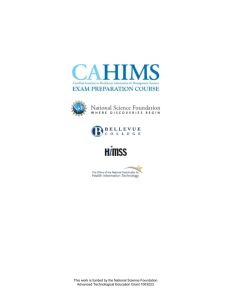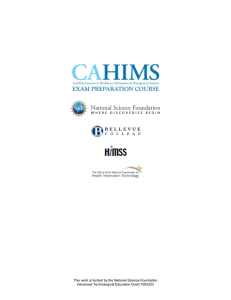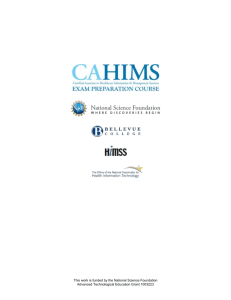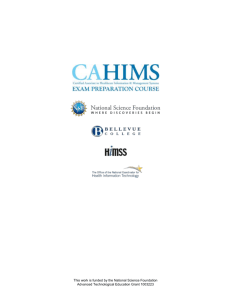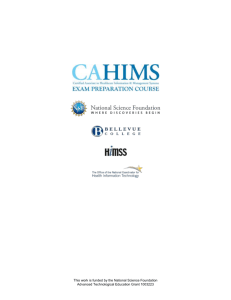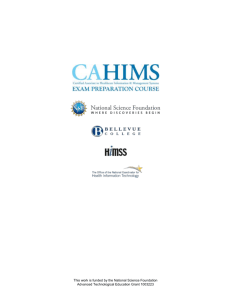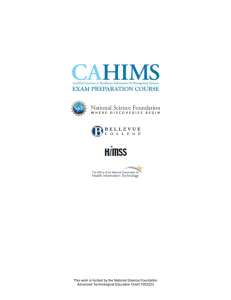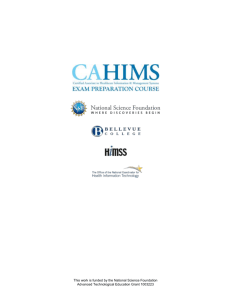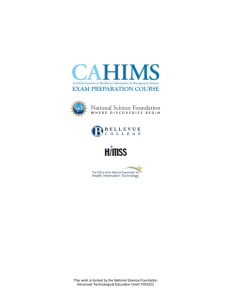9.4-Assessment-Key
advertisement
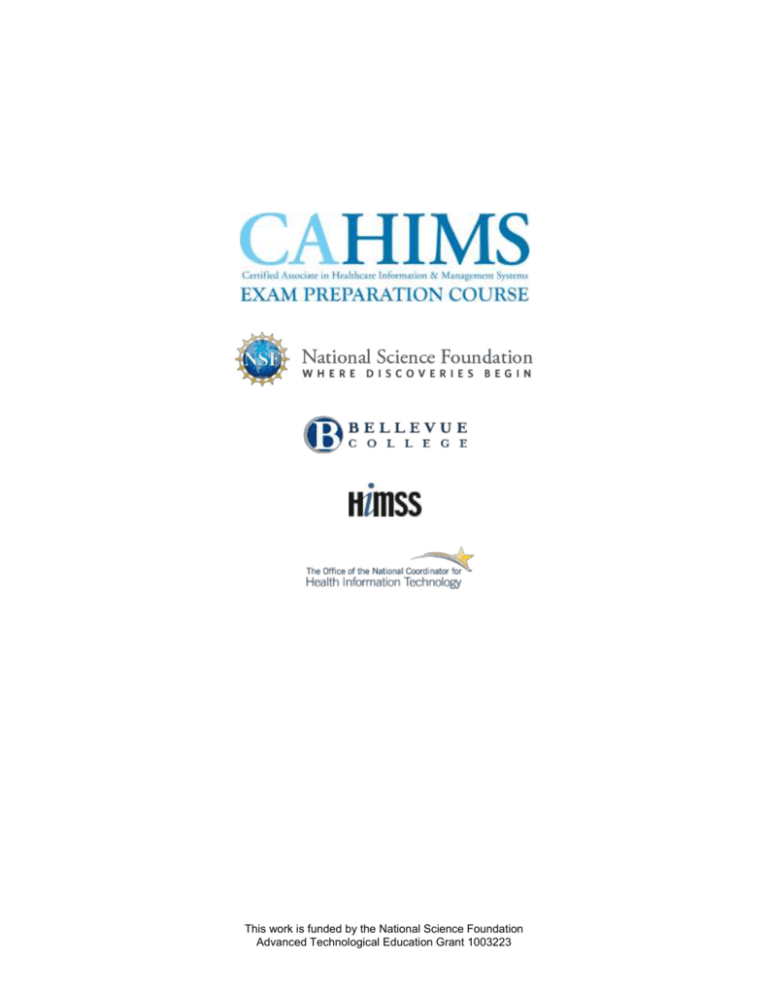
This work is funded by the National Science Foundation Advanced Technological Education Grant 1003223 The CAHIMS Exam Preparation Course and the CAHIMS exam are the result of collaboration between the Life Science Informatics Center at Bellevue College and the Healthcare Information and Management Systems Society (HIMSS). Significant content found in the CAHIMS Exam Preparation Course stems from the Office of the National Coordinator for Health Information Technology. Creation of the CAHIMS Exam Preparation Course and the CAHIMS exam was made possible through support from the National Science Foundation (NSF). Curriculum Team: Margaret Schulte, DBA Michèle Royer, PhD Nathan Savage, MLIS This work is funded by the National Science Foundation Advanced Technological Education Grant 1003223 Section 9 - Professionalism and Communication Skills Lesson 9.4 - Staying Current with Technology and Industry Assessment Questions Answer Key Lectures 2 & 3 1. Which of the following is not a role of the PHR? a. Help consumers make informed health care decisions. b. Engage consumers in their care. c. Supply information to health care providers. *d. Integrate the EHR and the PHR into a single record. Answer: d. The four main roles of the PHR are to help consumers make health care decisions, engage consumers in their care, supply information to health care providers, and integrate the delivery of health care and place the consumer at the center of their care. Lecture/Slide: 3/8 2. Health consumerism can be seen as an inhibitor in the development of patientcentric health information systems. a. True *b. False Answer: b. Health IT can bring together all the stakeholders including the consumer, health plan, and health care provider where information can be shared and used to the advantage of all. Health consumerism can be seen as a catalyst in the development of patient-centric health information systems. Lecture/Slide: 3/14 3. Which of the following is an example of how the Internet has affected consumer health informatics? *a. Provided the opportunity to contact the health care provider via e-mail. b. Created the ability to generate a physician bill. c. Afforded the option to opt out of supplying personal health information to drug companies. d. Given the ability to merge all data from health care providers and health plans into their personal health record. Answer: a. The Internet has affected consumer health informatics by making email exchange possible between consumers and health care providers. This work is funded by the National Science Foundation Advanced Technological Education Grant 1003223 Page 1 Lecture/Slide: 2/8 4. Social media is being used by health care organizations to a. Schedule patients for an appointment. b. Supply prices for services. *c. Build a reputation in the marketplace. d. Order supplies. Answer: c. Health care organizations are finding the use of social media can assist in building a reputation in the marketplace. Lecture/Slide: 2/10 5. A role of genomics in consumer health informatics is the connection to personalized medicine. *a. True b. False Answer: a. A role of genomics in consumer health informatics is the connection to personalized medicine. Physicians have the ability to “personalize” medical care by identifying the predisposition of a person to have a disease, and developing therapies adapted to genetic features of patients. Lecture/Slide: 2/16 Lecture 1 6. Medical calculators are helpful to have on a mobile device because a. doctors need to tabulate billing information accurately as they make various diagnoses. *b. some patients need drug doses tailored to their weight. c. time slots of varying length need to be scheduled on the calendar depending on the severity of a patient’s condition, d. they give the doctor the ability to show patients how much their prescription drugs may cost. Answer: b. some patients need drug doses tailored to their weight. Lecture(s)/Slide(s): 1/11 This work is funded by the National Science Foundation Advanced Technological Education Grant 1003223 Page 2 7. According to the lecture, which of the following reasons was NOT a reason for the failure of mobile devices to be widely adopted initially? a. Slow processors b. Short battery life *c. Too expensive d. Cumbersome data entry Answer: c. Too expensive Lecture(s)/Slide(s): 1/19 8. According to the lecture, the benefits of using mobile devices that have been documented by researchers include all of the following except: a. Cost savings *b. Better communication c. Error reduction d. Educational effectiveness Answer: b. Better communication Lecture(s)/Slide(s): 1/21-25 9. According to the lecture, one possible reason that primary care providers, compared to other doctors, use more robust features on their mobile devices is: *a. they see a wide-range of patients and need many capabilities. b. they tend to be younger and more tech-savvy. c. they are more likely to be male, thus be more into “gadgets.” d. they have more emphasis on health IT in residency training. Answer: a. they see a wide-range of patients and need many capabilities. Lecture(s)/Slide(s): 1/29 10. According to the lecture, new future uses of mobile devices in medicine are expected to include: a. Medical references *b. Access to health information exchange c. Medical calculation software d. Drug references Answer: b. Access to health information exchange This work is funded by the National Science Foundation Advanced Technological Education Grant 1003223 Page 3 Lecture(s)/Slide(s): 1/31 11. According to the lecture, which of the following marked the beginning of the mobile computing era? a. Palm Pilot b. Sony Clie *c. Newton Message Pad d. Blackberry Answer: c. Newton Message Pad Lecture(s)/Slide(s): 1/6 12. Mobile devices that have medical coding applications have the potential to benefit physicians. According to the lecture, which of the following features is most likely to produce a monetary benefit for physicians? a. When entering data, the app will alert the clinicians of any conflicting information. b. The app will apply codes that meet HITECH and ICD-10 specifications. *c. The app will register coded data based on the level of difficulty of care for and time spent with the patient d. Using the app will take less time than referencing a code book. Answer: c. The app will register coded data based on the level of difficulty of care for and time spent with the patient Lecture(s)/Slide(s): 1/13 13. Which of the following mobile device features presents the greatest challenge to the security of data? a. Drug referencing programs b. Clinical diagnostic support programs *c. EHR access and data entry programs d. Electronic prescribing Answer: c. EHR access and data entry programs Lecture(s)/Slide(s): 1/12, 31 This work is funded by the National Science Foundation Advanced Technological Education Grant 1003223 Page 4
